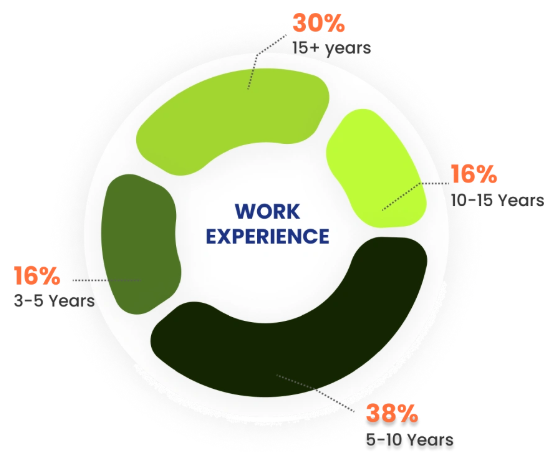MSME Govt of India Registered Autonomous institution.
Special session for working professionals, Business owners
Advance Certificate in PV Technology & Business Management (Online)
What you will learn?
1. Global Energy Scenario
Global Renewable Energy Scenario course would explore the current and future trends of renewable energy sources on a global scale.
Topics covered:
Market Scenario and Renewable Energy Sources, Applications of Solar Energy, State-wise Solar and Wind Capacity in India, Agricultural Solar Adoption, PM Surya Ghar Muft Bijli Yojana Scheme, Solar Power and Business Opportunities, Government Incentives, Bank Loans, GST, and Income Tax for Solar Projects, Solar Project Financing and Tax Benefits, Continuous Growth in the Solar Sector, Utility-Scale Projects, Growth of Solar Installation, Sector-wise Power Demand, State-wise Rooftop Solar Adoption Trends, Annual Rooftop Solar Installation Growth, Sector-wise SWOT Analysis, Establishing a Business and Vendor Registration for Government Projects.
Topics covered:
Market Scenario and Renewable Energy Sources, Applications of Solar Energy, State-wise Solar and Wind Capacity in India, Agricultural Solar Adoption, PM Surya Ghar Muft Bijli Yojana Scheme, Solar Power and Business Opportunities, Government Incentives, Bank Loans, GST, and Income Tax for Solar Projects, Solar Project Financing and Tax Benefits, Continuous Growth in the Solar Sector, Utility-Scale Projects, Growth of Solar Installation, Sector-wise Power Demand, State-wise Rooftop Solar Adoption Trends, Annual Rooftop Solar Installation Growth, Sector-wise SWOT Analysis, Establishing a Business and Vendor Registration for Government Projects.
2. Physics of PV Cell and Module
Photovoltaic (PV) cells, or solar cells, convert sunlight directly into electricity through the photovoltaic effect.
Topics covered:
Physics of Photovoltaic Systems, Semiconductor Materials, N-type and P-type Semiconductors, PN Junction and Current Flow, Solar Cell Effi ciency, Generations of Solar Cell Technology, PERC Solar Cell Technology, Multi-Busbar Solar Cells, Cut Cell Technology, Half-Cut and Third-Cut Cell Technology, High-Density Interconnection Panels, Tiling Ribbon (TR) Technology, N-Type Solar Cells, Integrated Back Contact (IBC) Solar Cells, All Back Contact (ABC) Solar Panels, Bifacial Solar Modules, Advanced Cell Technologies, Solar Panel Manufacturing Process, Evolution of Solar Cell Sizes and Power Output, Series vs. Parallel Connection of Solar Panels, Mismatch Issues, and Advancements in Solar Cell and Panel Size. Government Approved Panels (ALMM) and Review Questions.
Topics covered:
Physics of Photovoltaic Systems, Semiconductor Materials, N-type and P-type Semiconductors, PN Junction and Current Flow, Solar Cell Effi ciency, Generations of Solar Cell Technology, PERC Solar Cell Technology, Multi-Busbar Solar Cells, Cut Cell Technology, Half-Cut and Third-Cut Cell Technology, High-Density Interconnection Panels, Tiling Ribbon (TR) Technology, N-Type Solar Cells, Integrated Back Contact (IBC) Solar Cells, All Back Contact (ABC) Solar Panels, Bifacial Solar Modules, Advanced Cell Technologies, Solar Panel Manufacturing Process, Evolution of Solar Cell Sizes and Power Output, Series vs. Parallel Connection of Solar Panels, Mismatch Issues, and Advancements in Solar Cell and Panel Size. Government Approved Panels (ALMM) and Review Questions.
Outcome
Understanding Semiconductor Physics, PV Cell Structure and Operation, Emerging Technologies - Advanced Materials, Future Trends and Manufacturing Process.3. Solar Module Datasheet Analysis
A solar panel datasheet is a technical document detailing a solar module's performance, specifications, and characteristics. Understanding these datasheets is crucial for selecting the right panels for a solar energy system and ensuring optimal performance and longevity.
Topics covered:
Technical Specifi cations of Solar Panels, Standard Test Condition (STC), Nominal Operating Cell Temperature (NOCT), Voltage and Current Parameters, Temperature and Solar Radiation Effects, Fill Factor and Panel Quality, Effi ciency Calculation, Solar Panel Effi ciency Factors, Environmental Impact on Power Plant Efficiency, System and Component Considerations, Temperature Coefficient of PV Modules, Diode Usage in Solar Systems, Series and Parallel Connections, Solar Panel Specifi cation Sheet - Electrical Characteristics, Thermal Characteristics and Temperature Coefficients, Mechanical Characteristics, Solar Cell Type and Size, Solar Panel Warranty, Bifacial Solar Panels, Factors Affecting Bifacial Gain, Refl ectivity and Bifacial Gain, Solar Panel Degradation and Damage, Performance Warranty, Solar Panel Manufacturing and Export from India, DCR vs. Non-DCR Solar Panels and Homework Assignment.
Topics covered:
Technical Specifi cations of Solar Panels, Standard Test Condition (STC), Nominal Operating Cell Temperature (NOCT), Voltage and Current Parameters, Temperature and Solar Radiation Effects, Fill Factor and Panel Quality, Effi ciency Calculation, Solar Panel Effi ciency Factors, Environmental Impact on Power Plant Efficiency, System and Component Considerations, Temperature Coefficient of PV Modules, Diode Usage in Solar Systems, Series and Parallel Connections, Solar Panel Specifi cation Sheet - Electrical Characteristics, Thermal Characteristics and Temperature Coefficients, Mechanical Characteristics, Solar Cell Type and Size, Solar Panel Warranty, Bifacial Solar Panels, Factors Affecting Bifacial Gain, Refl ectivity and Bifacial Gain, Solar Panel Degradation and Damage, Performance Warranty, Solar Panel Manufacturing and Export from India, DCR vs. Non-DCR Solar Panels and Homework Assignment.
Outcome
Understanding Solar Module, Interpreting Datasheet Specifications - Electrical Characteristics, Mechanical Specifications, Operating Conditions, Safety and Certification and Staying Updated with Industry Trends4. Solar Resource Assessment
Solar resource assessment is the process of evaluating a location's solar energy potential to determine the viability of a solar power project. This involves collecting and analyzing solar irradiance data, along with other meteorological data, to accurately estimate the amount of energy that can be generated.
Topics covered:
Solar Resource Data and Irradiation Assessment, Solar Energy and Radiation Spectrum, Solar Radiation and Measurement, Shadow Analysis and Solar Window, Sun Path Diagram and Solar Angles, Shading Assessment Using Solar Angles and Tools, Air Mass and Solar Window Details, Solar Declination Angle, Tilt Angle Importance, Optimum Tilt Angle Calculation, Altitude Angle, Sessional vs. Fixed Tilt Angle, Tilt Angle Based on Location, Panel Spacing, Table for Solar Panel Mounting, Solar Resource Data and System Design, Practical Aspects of Tilt Angle Adjustment and Hometask Assignment.
Site Suitability Assessment - Feasibility Studies, Plant Performance Analysis, Factors Affecting Solar Potential
Data Collection and Analysis Techniques - Onsite Measurements, Resource data access, Data Validation
Topics covered:
Solar Resource Data and Irradiation Assessment, Solar Energy and Radiation Spectrum, Solar Radiation and Measurement, Shadow Analysis and Solar Window, Sun Path Diagram and Solar Angles, Shading Assessment Using Solar Angles and Tools, Air Mass and Solar Window Details, Solar Declination Angle, Tilt Angle Importance, Optimum Tilt Angle Calculation, Altitude Angle, Sessional vs. Fixed Tilt Angle, Tilt Angle Based on Location, Panel Spacing, Table for Solar Panel Mounting, Solar Resource Data and System Design, Practical Aspects of Tilt Angle Adjustment and Hometask Assignment.
Outcome
Understanding Solar Radiation - Sun-Earth Geometry, Irradiance Data, Measurement and Analysis, Shadow AnalysisSite Suitability Assessment - Feasibility Studies, Plant Performance Analysis, Factors Affecting Solar Potential
Data Collection and Analysis Techniques - Onsite Measurements, Resource data access, Data Validation
5. Solar plant Balance of System
The "Balance of System" (BOS) in a solar plant refers to all the components and costs excluding the solar panels themselves. It encompasses everything needed to convert, control, and deliver the electricity generated by the solar panels.
Topics covered:
Balance of System Introduction, Module Connection and Array Junction Box, DC to AC Conversion and Distribution, System Safety, Standalone Systems, Hybrid Solar Systems, Grid-Tie or On-Grid Systems, DC and AC Buses, Net Metering and Gross Metering, Large-Scale Power Plant Diagram, Monitoring Systems for Performance,
Balance of System Components (Detailed), Solar Charge Controllers (Types and Function), Battery Charging Process, PWM Charge Controller Specifi cations, MPPT Charge Controller Features, MPPT System Voltage and Technical Data Sheets
Inverter Basics, Types of Inverters Based on System and Application, Based on Phase and Transformer, Micro and String Inverter Details, String vs. Central vs. Micro Inverters, Key Parameters of Hybrid Inverter and Data Sheet, Comparison of Different Inverter Data Sheets, Communication Interfaces and Off-Grid Capability, Monitoring Systems and Customer Benefits, Three-Phase Inverters, MPPT Trackers, AC Output and Effi ciency of Three-Phase Inverters, DC and AC Sides of a Solar System, Energy Conversion Losses and Effi ciency, DC to AC Ratio and Oversizing, Solar System Warranty and Homework
Array Junction Box (AJB), AJB Installation and Operation, Multiple String Confi guration, ACDB and Inverter Integration, Multi-Input AJB Confi gurations, Series vs. Parallel Connections, Surge Protection Device (SPD) Functionality, Solar DC Cable, Grounding in Solar Systems, Plant Layout and Installation Considerations, IP Rating of Enclosures, MC4 Connectors for DC Wiring, Cable and Fuse Sizing, Solar Panel Mounting Structures, Installation Best Practices, Calculating Mounting Structure Components, Project Site Overview and Components and Hometask Assignment.
Topics covered:
Balance of System Introduction, Module Connection and Array Junction Box, DC to AC Conversion and Distribution, System Safety, Standalone Systems, Hybrid Solar Systems, Grid-Tie or On-Grid Systems, DC and AC Buses, Net Metering and Gross Metering, Large-Scale Power Plant Diagram, Monitoring Systems for Performance,
Balance of System Components (Detailed), Solar Charge Controllers (Types and Function), Battery Charging Process, PWM Charge Controller Specifi cations, MPPT Charge Controller Features, MPPT System Voltage and Technical Data Sheets
Inverter Basics, Types of Inverters Based on System and Application, Based on Phase and Transformer, Micro and String Inverter Details, String vs. Central vs. Micro Inverters, Key Parameters of Hybrid Inverter and Data Sheet, Comparison of Different Inverter Data Sheets, Communication Interfaces and Off-Grid Capability, Monitoring Systems and Customer Benefits, Three-Phase Inverters, MPPT Trackers, AC Output and Effi ciency of Three-Phase Inverters, DC and AC Sides of a Solar System, Energy Conversion Losses and Effi ciency, DC to AC Ratio and Oversizing, Solar System Warranty and Homework
Array Junction Box (AJB), AJB Installation and Operation, Multiple String Confi guration, ACDB and Inverter Integration, Multi-Input AJB Confi gurations, Series vs. Parallel Connections, Surge Protection Device (SPD) Functionality, Solar DC Cable, Grounding in Solar Systems, Plant Layout and Installation Considerations, IP Rating of Enclosures, MC4 Connectors for DC Wiring, Cable and Fuse Sizing, Solar Panel Mounting Structures, Installation Best Practices, Calculating Mounting Structure Components, Project Site Overview and Components and Hometask Assignment.
Outcome
Understanding BOS Components, Industry Standards and Regulations, System Economics, System Design and Integration, Safety Practices SCADA System Understanding6. Rooftop Project Introduction & Electric Bill Saving
These projects involve installing solar panels on rooftops, which then feed electricity into the home's power grid.
Any excess electricity generated can be sent back to the grid, often resulting in credits or compensation through net metering. The main benefit is a substantial decrease in electricity costs, potentially leading to zero bills in some cases.
Topics covered:
Solar Project Introduction, Capacity Calculation and System Sizing, Rooftop Residential Projects, Project Proposal and Financial Benefits, System Sizing and Customer Needs, Customer Budget and Space Availability, Commercial and Technical Parameters, Estimating Energy Use and System Size Calculation, Optimum System Design and Grid Interaction, Site Assessment - Electrical Load and Solar Resources, Site Survey Considerations, Calculating Installed Capacity and Energy Yield, Capacity Utilization Factor, Government Support and Incentives, Grants, Rebates, and Loans for Solar Power, Net Metering and Feed-in Tariff Policies, Solar Tenders and Business Opportunities, Financial Aspects and Energy Cost Calculation, Site Survey and Home Task
Power Plant Sizing Calculation and ROI, Tariff File Analysis, Calculating Optimum System Size, Analyzing Energy Consumption and Charges, Solar System Size and Savings, Return on Investment, Financial Assistance and Net Cost, Long-Term Savings and Profitability, Tariff Files and Commercial Benefits, Project Cost and Profit Margi Practical Considerations for Installation and Home Task
Topics covered:
Solar Project Introduction, Capacity Calculation and System Sizing, Rooftop Residential Projects, Project Proposal and Financial Benefits, System Sizing and Customer Needs, Customer Budget and Space Availability, Commercial and Technical Parameters, Estimating Energy Use and System Size Calculation, Optimum System Design and Grid Interaction, Site Assessment - Electrical Load and Solar Resources, Site Survey Considerations, Calculating Installed Capacity and Energy Yield, Capacity Utilization Factor, Government Support and Incentives, Grants, Rebates, and Loans for Solar Power, Net Metering and Feed-in Tariff Policies, Solar Tenders and Business Opportunities, Financial Aspects and Energy Cost Calculation, Site Survey and Home Task
Power Plant Sizing Calculation and ROI, Tariff File Analysis, Calculating Optimum System Size, Analyzing Energy Consumption and Charges, Solar System Size and Savings, Return on Investment, Financial Assistance and Net Cost, Long-Term Savings and Profitability, Tariff Files and Commercial Benefits, Project Cost and Profit Margi Practical Considerations for Installation and Home Task
Outcome
Bill Reduction, Calculating the required capacity of a rooftop solar system based on energy consumption and available space, Financial Analysis and Savings, Regulations and Permitting, Design and implement rooftop solar systems, Evaluate the feasibility and financial benefits of solar projects, Environmental Benefits7. Rooftop Hybrid Solar Power Plant Design
A rooftop solar power plant design involves careful consideration of several factors to ensure optimal energy generation and structural integrity.
Topics covered:
Hybrid System Design, Load Assessment and Energy Calculation, Inverter Sizing, Battery Bank Sizing, Battery Selection, PV Array Design, Battery Bank Configuration, Solar Radiation and Data Sourcing , Inverter and PV Module Configuration, System Design and Costing, Location-Based System Adjustments and Assignment and Project Submission
Topics covered:
Hybrid System Design, Load Assessment and Energy Calculation, Inverter Sizing, Battery Bank Sizing, Battery Selection, PV Array Design, Battery Bank Configuration, Solar Radiation and Data Sourcing , Inverter and PV Module Configuration, System Design and Costing, Location-Based System Adjustments and Assignment and Project Submission
Outcome
Technical Skills & Knowledge - System Design, Software Proficiency, System Components selection, Costing and Estimation, Performance Analysis, Safety and Commissioning, Maintenance & Troubleshooting8. Commercial-Tariff Calculation
Tariff Based Competitive Bidding Process for Procurement of Power from Grid Connected Solar PV Power Projects.
Topics covered:
Commercial Customer Electricity Bill Savings, Commercial Electricity Bill Components, Maximum Demand and Energy Consumption, Fuel Adjustment Cost and Slot-Wise Rates, Total Electricity Bill Calculation, Solar System Sizing and Cost, Return on Investment and Benefits of Solar, Business Models for Solar, Solar Project Investment and Returns, Optimal System Size Calculation, AC vs. DC Power Plant Size, Techno-Commercial Reports and Home Task - updated excel Tariff File and self Presentations.
Topics covered:
Commercial Customer Electricity Bill Savings, Commercial Electricity Bill Components, Maximum Demand and Energy Consumption, Fuel Adjustment Cost and Slot-Wise Rates, Total Electricity Bill Calculation, Solar System Sizing and Cost, Return on Investment and Benefits of Solar, Business Models for Solar, Solar Project Investment and Returns, Optimal System Size Calculation, AC vs. DC Power Plant Size, Techno-Commercial Reports and Home Task - updated excel Tariff File and self Presentations.
9. Solar Power Plant Design Software
Solar power plant design software helps engineers and developers create efficient and cost-effective solar energy systems. These tools simulate energy production, analyze shading, and optimize layouts, ultimately aiding in the design of both small-scale and large-scale solar installations.
Topics covered:
Software Introduction, Software Features and Functionality, File Menu Overview, User and System Settings, Project Design Options, Database Menu and Component Data, Metrological Data and Location Selection, Metro Data Comparison for Large-Scale Projects, Tool Menu and Graphical Presentations, Project Settings and Temperature Data, Temperature Considerations for Project Design, Panel Orientation and Energy Optimization, Panel and Inverter Selection, Battery and Charge Controller Data, Simulation and Tariff Clarifications
Topics covered:
Software Introduction, Software Features and Functionality, File Menu Overview, User and System Settings, Project Design Options, Database Menu and Component Data, Metrological Data and Location Selection, Metro Data Comparison for Large-Scale Projects, Tool Menu and Graphical Presentations, Project Settings and Temperature Data, Temperature Considerations for Project Design, Panel Orientation and Energy Optimization, Panel and Inverter Selection, Battery and Charge Controller Data, Simulation and Tariff Clarifications
Outcome
Understanding Solar PV System Design Simulation - Site Assessment and Analysis, System Design and Simulation, Performance Analysis, Financial Modeling and Project Planning, Understanding Industry Standards, Project Implementation and Documentation10. MW scale project design
Designing a MW-scale solar PV project using PV software involves defining the project site, importing site data, selecting components, and simulating performance.
Key aspects include accurately modeling shading, choosing appropriate inverters and panels, and optimizing tilt angles for maximum energy yield.
Simulation results provide insights into energy production, performance ratio, and financial viability.
Topics covered:
Project Location Selection, Key Performance Formula, Probability in PV System Design, Solar Resource and Temperature Considerations, PV Module Specification Analysis, Inverter Specification Analysis, Manual Calculation for 500 kW System, Software Simulation and System Design, Consideration of Loss Factors, Aging Factor and Unavailability, Spectral Correction, Shading, and Energy Management, Shading Analysis and Simulation, Grid Power Limitation and Economical Evaluation, Energy Prediction and Performance Ratio, Meteo Data and Simulation Uncertainties, Costing and Carbon Dioxide Emission, Optimization Tool and Simulation Accuracy, Financial Analysis and Report , Detailed Economical Results, Cash Flow Diagram, Inverter String Configuration and Safety Checks, Table for Solar Panel Mounting, System Architecture and Monitoring, DC and AC Side Calculations for Fuse and SPD Sizing and Home Task - 1MW Ground Mounted plant design present on next day's class.
Topics covered:
Project Location Selection, Key Performance Formula, Probability in PV System Design, Solar Resource and Temperature Considerations, PV Module Specification Analysis, Inverter Specification Analysis, Manual Calculation for 500 kW System, Software Simulation and System Design, Consideration of Loss Factors, Aging Factor and Unavailability, Spectral Correction, Shading, and Energy Management, Shading Analysis and Simulation, Grid Power Limitation and Economical Evaluation, Energy Prediction and Performance Ratio, Meteo Data and Simulation Uncertainties, Costing and Carbon Dioxide Emission, Optimization Tool and Simulation Accuracy, Financial Analysis and Report , Detailed Economical Results, Cash Flow Diagram, Inverter String Configuration and Safety Checks, Table for Solar Panel Mounting, System Architecture and Monitoring, DC and AC Side Calculations for Fuse and SPD Sizing and Home Task - 1MW Ground Mounted plant design present on next day's class.
Outcome
Site Assessment and Feasibility, System Sizing and Design, Component Selection, Detailed Project Report (DPR) Preparation, Understanding Financial Aspects, including Discounted Cash Flow (DCF), Internal Rate of Return (IRR), Levelized Cost of Energy (LCOE), and capital expenditure (CAPEX)/operational expenditure (OPEX), Bill of Quantities (BoQ) Preparation,11. Bifacial System Design and BoQ
Effective bifacial system design requires careful consideration of factors like ground reflectance, module spacing, and the bifaciality factor of the panels.
Topics covered:
Bifacial Module System Design, Optimizing Bifacial Module Performance, Cost and Installation Considerations for Bifacial Modules, Impact of Ground Albedo and System Generation, Bill of Quantity (BOQ) Preparation, Professional Presentation of Project Costs, Home Task - Design 1 megawatt projects in five different locations, changing only the location while keeping the panel and inverter the same, to optimize the system and compare generation reports.
Topics covered:
Bifacial Module System Design, Optimizing Bifacial Module Performance, Cost and Installation Considerations for Bifacial Modules, Impact of Ground Albedo and System Generation, Bill of Quantity (BOQ) Preparation, Professional Presentation of Project Costs, Home Task - Design 1 megawatt projects in five different locations, changing only the location while keeping the panel and inverter the same, to optimize the system and compare generation reports.
Outcome
Understanding Bifacial Technology - Fundamentals of Bifacial Modules, Bifacial Gain, Factors Affecting Performance, Modeling and Simulation12. PV Project Documents
PV (Photovoltaic) project documentation refers to the collection of documents required for the planning, execution, and
operation of a solar power project. This documentation includes technical specifications, financial details, and
project management plans. Key documents often include site plans, system designs, component specifications, financial models,
and permits.
Topics covered:
Documentation in PV Design, Project Report and User Guides, Array Junction Box (AJB) Drawing, Power Plant Electrical Diagram and Layout, Earthing System and Lightning Protection, Module Installation and String Configuration, Rooftop Installation Considerations, Detailed Project Report (DPR) - Site Assessment in the DPR, Solar Radiation Resource Assessment in the DPR, Project Scenarios and Power Purchase Agreements (PPAs), Small Project Report Making, Work Order and Procurement, Business Strategy and Proposal Development, Technical Proposal Details, Commercial Estimation and Terms.
Topics covered:
Documentation in PV Design, Project Report and User Guides, Array Junction Box (AJB) Drawing, Power Plant Electrical Diagram and Layout, Earthing System and Lightning Protection, Module Installation and String Configuration, Rooftop Installation Considerations, Detailed Project Report (DPR) - Site Assessment in the DPR, Solar Radiation Resource Assessment in the DPR, Project Scenarios and Power Purchase Agreements (PPAs), Small Project Report Making, Work Order and Procurement, Business Strategy and Proposal Development, Technical Proposal Details, Commercial Estimation and Terms.
Outcome
Identifying Key Documents, Understanding Document Purpose, Contributing to Document Development, Reading and interpreting electrical schematics, Understanding bill of materials (BOM), Understanding site assessment reports, Understanding installation plans, Understanding operation and maintenance (O&M)13. PM Surya Ghar Business Guide
PM Surya Ghar Business Guide:
Topics covered:
Vendor registration, PM Surya Ghar Application Soumission Documents, Documents required for online application, PM Surya Ghar Project Feasibility Approval, Technical feasibility, Regulatory and logistical feasibility, Financial feasibility, Required installation detail documents, the DISCOM inspaction - plant's performance ratio (PR) to qualify PM Surya Ghar grant, DISCOM Inspection Process etc.
Every steps guide.
Topics covered:
Vendor registration, PM Surya Ghar Application Soumission Documents, Documents required for online application, PM Surya Ghar Project Feasibility Approval, Technical feasibility, Regulatory and logistical feasibility, Financial feasibility, Required installation detail documents, the DISCOM inspaction - plant's performance ratio (PR) to qualify PM Surya Ghar grant, DISCOM Inspection Process etc.
Every steps guide.
14. Overall discussion and Business Guide
A business guide for solar photovoltaic (PV) systems involves understanding the market, developing a robust business model, and navigating the complexities of the industry.
Topics covered:
Training Session Review, Project Submission and Examination, Recommended Resources for Solar Professionals, Solar Tender Portals,
Guide to registered business, technical expertise, and how can you compliant firm with all statutory and safety requirements to become a PM Surya Ghar vendor
Starting a Solar Business: Trade Name Registration, Steps to Starting a Solar Business, Trademark Registration, GST and MSME registrations, Website Development for Business, Business and Branding Strategy, Marketing and Promotion, Website Optimization and Visibility, Nodal Agencies and Financial Institutions, Government Initiatives, Supplier and Agency Networking, Project Proposals and Securing Work, Partnerships and Large-Scale Projects and Post-Training Support from Institute of Solar Technology.
Topics covered:
Training Session Review, Project Submission and Examination, Recommended Resources for Solar Professionals, Solar Tender Portals,
Guide to registered business, technical expertise, and how can you compliant firm with all statutory and safety requirements to become a PM Surya Ghar vendor
Starting a Solar Business: Trade Name Registration, Steps to Starting a Solar Business, Trademark Registration, GST and MSME registrations, Website Development for Business, Business and Branding Strategy, Marketing and Promotion, Website Optimization and Visibility, Nodal Agencies and Financial Institutions, Government Initiatives, Supplier and Agency Networking, Project Proposals and Securing Work, Partnerships and Large-Scale Projects and Post-Training Support from Institute of Solar Technology.
Past Participant Profile

Top Job Profiles
- Director/Founder
- Programme Managers
- Project Lead/Project Mgrs
- EPC Associate
- Startup
Quick Inquiry Form
Several institutions play a significant role in PV solar technology training in India.
Notably, the Institute of Solar Technology (IST) has trained over 100000 solar entrepreneurs since 2014 and
offers online and practical courses focused on development and quality management of solar power projects,
including rooftop and ground-mounted systems.

Interactive Classes

Practical & Doubt Classes

E-Library Study Materials

Online Examination















